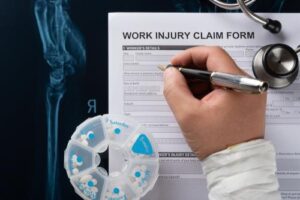
You may wonder what the most common types of scaffold accidents and injuries are if your work requires you to use scaffolds on a daily basis. If you’ve been swept up in the whirlwind of a scaffold accident, you’re not alone. These incidents are more common than you might think, and they leave a trail of physical and emotional scars on their victims.
Some of the most common accidents are falls and injuries due to falling objects; however, many different injuries can result from a scaffold accident. If you were injured in a scaffold accident during working hours, contact an Atlanta worker’s compensation lawyer to figure out the best way to claim compensation for your damages.
Common Injuries in Scaffold Accidents
Experienced Atlanta personal injury attorneys often see any number of scaffolding accident injuries, including:
- Broken bones. Falls from any height can shatter wrists, ankles, legs, ribs – the list goes on. The severity depends on your unlucky encounter with gravity and the unforgiving ground below.
- Head injuries. Head injuries from scaffold accidents can be silent assassins lurking beneath seemingly minor bumps. Concussions, whiplash, and even life-threatening internal bleeding can hide until it’s too late. Remember, any head trauma in a fall warrants immediate medical attention.
- Spinal cord injuries. Even a small tumble can cause a spinal cord injury, damaging the delicate nerves in your spine and leading to paralysis, tingling, and chronic pain.
- Emotional consequences. Fear, anxiety, and even post-traumatic stress disorder (PTSD) can be the unseen wounds of a traumatic accident. Remember, seeking mental health support after such an experience is a sign of strength, not weakness.
Every accident is unique, and your injuries might be different. The most important thing is to get immediate medical attention and begin the healing process. And if you suspect negligence played a role in your fall, an experienced personal injury lawyer can aid you on the road to recovery, both physically and emotionally.
Get the strong arm
What Should I Do After a Scaffold Accident to Pursue Damages?
In the chaos of a scaffold accident, knowing what to do next can feel impossible. But take a deep breath – John Foy & Associates are here to be your strong arm every step of the way.
First things first: safety and medical care are paramount. Get yourself checked out immediately, even if you think the injuries are minor. Head trauma, spinal cord damage, and internal bleeding can lurk beneath the surface, so don’t hesitate to seek medical attention. Your health is always the top priority.
Once you’re stable, it’s time to start building your case. Here are some crucial steps:
- Gather evidence. That could include photos of the accident scene, any defective equipment, and witness statements. Keep any medical records and bills related to your injuries.
- Report the accident. Inform your supervisor and file an official accident report with your employer. That is required by law and establishes a paper trail.
- Contact a personal injury lawyer. An experienced lawyer can navigate the legal complexities, investigate your case, and fight for the compensation you deserve. Remember, John Foy & Associates offers free consultations and a no-win, no-fee policy, so you don’t have to worry about upfront costs.
- Focus on recovery. Getting better is your top priority. Your lawyer will handle the legal battles while you focus on healing, both physically and emotionally. Remember, emotional distress is a valid form of damage, and seeking mental health support after a traumatic experience is a sign of strength.
It’s important to act quickly. Statutes of limitations, or legal deadlines, for filing claims exist. The sooner you contact a personal injury lawyer, the better chance you have of securing the compensation you deserve.
What Type of Compensation Am I Entitled to After a Scaffold Accident in the Workplace?
The aftermath of a workplace scaffold accident can feel overwhelming. Don’t worry; we’re here to clear the air and guide you through the maze of compensation.
First, understand the landscape:
Workers’ Compensation
That is your initial safety net. It provides medical coverage and partial wage replacement if you’re injured on the job, regardless of fault. It’s a no-fault system, meaning you don’t need to prove anyone was negligent, but benefits have limitations.
If you were severely injured, you may need to talk to an Atlanta social security disability lawyer to navigate the process and ensure you receive all the benefits to which you are entitled.
Compensatory Damages
These aim to reimburse you for the actual losses caused by your injuries. They fall into two categories:
Economic Damages cover tangible losses like:
- Medical expenses. Past, present, and future medical bills related to your injuries.
- Lost wages. Compensation for income you couldn’t earn due to your injuries.
- Property damage. Damage to your personal belongings due to the accident.
Non-economic damages compensate for your intangible losses, such as:
- Pain and suffering. Physical and emotional pain and discomfort caused by your injuries.
- Loss of enjoyment of life. Inability to participate in activities you used to enjoy due to your injuries.
- Loss of consortium. Impact on your relationships with family and loved ones.
Punitive Damages
These are rarely awarded but serve as a punishment for intentional or reckless misconduct. In extreme cases, like when the responsible party knew the scaffold was unsafe but neglected to fix it, punitive damages might be an option.
How Much Is My Scaffold Accident Case Worth?
There is a difference between punitive and compensatory damages. how much you get depends on factors like:
- The severity of your injuries. More severe injuries generally lead to higher compensation.
- Lost wages. The longer you’re out of work, the greater the economic damage.
- Long-term impact. Permanent disabilities or chronic pain can significantly increase compensation.
- Negligence of the responsible party. If someone was clearly negligent, your compensation may be higher.
Remember, The Strong Arm of the John Foy Law firm is by your side to analyze your case, calculate your potential compensation, and negotiate aggressively for the maximum amount you deserve. They can also explore additional avenues for compensation, like suing third-party manufacturers for defective equipment.
What Is the Statute of Limitations for Scaffold Accidents in Georgia?
Knowing the statute of limitations for your case is crucial, and in Georgia, it comes with a specific timeframe.
In Georgia, the statute of limitations for personal injury claims, including scaffold accidents, is two years from the date of your injury. That means you have two years to file a lawsuit against any party you believe was negligent and caused your fall.
Why is this deadline important? Missing it can bar you from seeking compensation in court. It’s not impossible to pursue other avenues after two years, but your options become significantly limited.
Talk to the Strong Arm Today for the Legal Representation You Deserve
The aftermath of a scaffold accident can leave you feeling battered, bruised, and lost. But scaffold accidents can also bring huge financial burdens, lingering pain, and endless questions about your recovery and your future. However, if someone else was liable, you may be entitled to claim compensation.
You don’t have to face this alone. John Foy & Associates are your strong arm, ready to guide you through the legal maze and fight for the compensation you deserve. Take the first step towards recovery and financial security. Talk to the strong arm today. Contact John Foy & Associates.
404-400-4000 or complete a Free Case Evaluation form





